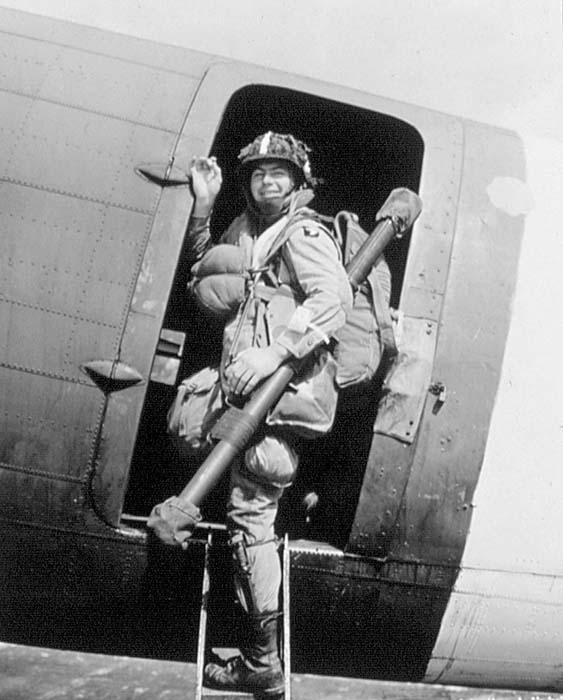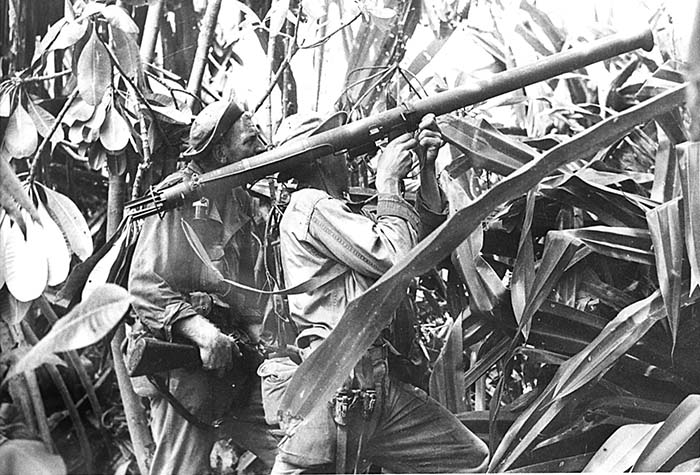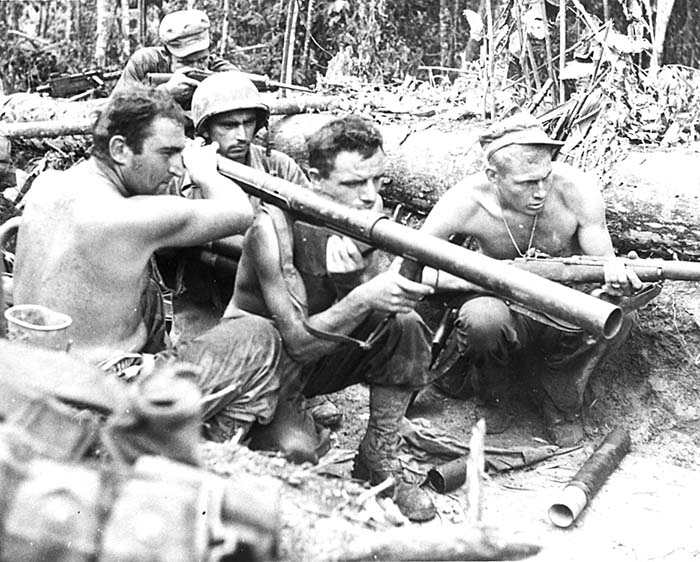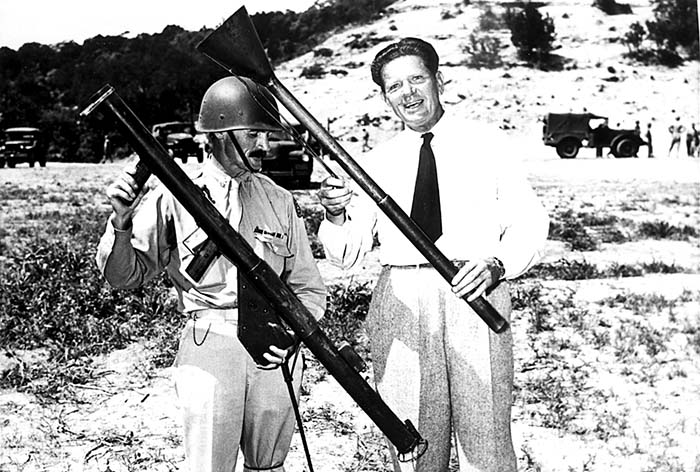By Robert Bruce
“The only really revolutionary new American weapon that got overseas in time for widespread combat use was the 2.36-inch rocket and launcher known as the bazooka….”
From The Ordnance Department: On Beachhead and Battlefront, L. Mayo, Office of The Chief of Military History, 1968, USGPO
Men Against Tanks
Developed and fielded in record time on a shoestring budget in the dark, early months of WWII, the bazooka was the first practical device to give the infantryman a fighting chance against most tanks of the period. A clever combination of centuries-old rocket propulsion and newly-fielded explosives technology, it proved equally useful in dealing with many commonly encountered field fortifications such as log bunkers.
Rockets and Warheads
A US Army Ordnance officer by the name of Skinner is widely credited with invention of what was to become the bazooka, beginning work at Aberdeen Proving Ground in the early 1930’s. The young captain apparently achieved some success with firing various types of rockets from a variety of troughs and tubes. However, since this sort of thing had been a staple of warfare since the Middle Ages, the real challenge was how to maximize effectiveness of the rocket’s warhead.
But, according to Terry Gander in his highly entertaining and informative new book, The Bazooka, Skinner’s eventual triumph of engineering owes much to the work of both US Navy Lieutenant Uhl and a Swiss fellow named Henri Mohaupt. As the legend goes, Mohaupt’s innovative hollow-charge anti-armor rifle grenades had been demonstrated for the British and the principle was appropriated for the warhead of the infamous PIAT spigot launcher. Soon afterward, he came to America with his wares only to be politely told that his “secret” new design actually dated back to German experimentation in 1911.
The essential element of Mohaupt’s ammunition comes from the astonishing efficiency of the so-called “shaped charge” where the explosive filler is formed into a hollow cone with its rim facing the target. Detonated from the base of the cone, the resulting shock wave and superheated jet are concentrated into a small area, simultaneously burning and blasting through thick steel armor. This phenomenon gives unsurpassed punch to relatively small and light warheads, making an individually man-portable antitank weapon practical for the first time.
Rifle Grenades and Rockets
The M9 rifle grenade, a muzzle-launched munition, was the first American use of shaped charge design. Aerodynamically efficient with its rounded nose and cylindrical tail, the 1.31 pound minibomb was propelled by a special high pressure blank to a maximum range of some 215 yards. Although it could penetrate about four inches of common armor plate, it wasn’t suitable against most enemy tanks other than for blowing off the tracks. However, the M9 proved very useful for many other challenges including house-to-house fighting and was used throughout WWII on all fronts.
The M10 antitank rifle grenade, a considerably more powerful version fielded at about the same time, was found to be impractical for general issue because it was too heavy to be launched from a rifle. But Captain Skinner recognized that its size and weight would be no real liability as the self-propelled rockets that he was experimenting with on rudimentary metal tube launchers. This soon proved correct on the test range and in June of 1942 — just a couple of months since America had entered the war — General Electric Corp. delivered 5000 of the new top-secret weapons code named “The Whip.”
Formally designated as “Launcher, Rocket, Anti-Tank, 2.36 inch, M1,” (60mm inside diameter) and firing the “Rocket, High Explosive, Anti-Tank, 2.36 inch, M6,” the first of these brand-new weapons were immediately sent to beleaguered American troops in North Africa in September, 1942, and to our Soviet allies. Unfortunately, some soon fell into German hands and emerged a short time later in bigger, better form as the 88mm Panzerschreck.
The Spike Jones Connection
Wisecracking GI’s immediately began calling the new weapon “The Bazooka,” because of its obvious resemblance to a bizarre musical instrument created by Bob Burns, a member of the zany and very popular musical comedy group Spike Jones and the City Slickers. Soon afterward, Burns did his bit for the war effort by posing for an Army publicity photo with his “music-destroying bazooka” in comparison to the high-explosive version. The nickname has become so thoroughly ingrained in popular culture that virtually every man-portable rocket launcher since then is known by this colorful designation.
Orient Express
“The bazooka turned out to be fairly useful against Japanese bunkers, mostly for concussion effect against the occupants; but battery failure was frequent because of jungle moisture.” US Army Technical Intelligence Report 473, 2 Oct 44
With German tanks as Priority One for the first batches of bazookas, troops in the Pacific had to wait awhile for theirs. Although there were relatively few Japanese tanks and most of these were lightly armored, there was much other work that could be done quite well by their high explosive warheads and 600 yard maximum range.
The Japanese were skilled at building well protected bunkers of concrete, earth and logs. These were almost impossible to take out with mortars, so soldiers and marines had to inch their way up close enough to use hand and rifle grenades, flamethrowers and satchel charges. But when the stovepipe launchers finally arrived the flat-shooting, fast moving bazooka rocket was just the ticket for putting one right through the firing port from a relatively safe distance, or into the mouth of a hillside cave.
Inevitably, the humid and fungus-friendly environment of jungle warfare was particularly hard on electrical connectors. This played havoc on all sorts of equipment including radios, but was particularly tough on the dry-cell battery powered firing circuit of the M1 bazooka. This was helped somewhat by introduction of the M9 version, featuring a magneto ignition. Portability also got a boost when the two section, quick-coupling M9A1 was fielded in response to requirements of the paratroops.
Get the Point
Ammunition for the weapon system also got the product-improvement treatment during the war, including changes to motor and fuzing, based on sometimes tragic incidents. While the pointed-nose M6 rocket was a very streamlined design for efficient flight, it tended to be deflected when hitting armor at sharp angles. Accordingly, the “ogive” or nose, was changed to a blunt dome and the straight fins were discarded in favor of a cylindrical stabilizer. Interestingly, the new rocket, first designated M6A3, looks like a beefed-up version of the Army’s original rifle grenade, the M9.
While the WWII American bazooka started a trend in antiarmor weaponry that continues even today, its 2.36 inch/60mm rocket was only barely effective. Despite German fielding of the bigger Panzerschreck, this bad situation wasn’t substantially corrected until the opening months of the Korean War when GI’s were being overrun by Soviet-supplied T34 tanks. The resulting 3.5 inch launcher was eventually replaced by a 90mm Recoilless Rifle in Vietnam and the one-shot, throwaway 66mm Light Antitank Weapon.
Primary Reference Sources: The Bazooka by Terry Gander, PRC Publishing, London, 1998 and FM 23-30, US War Department, 1944.
| This article first appeared in Small Arms Review V4N3 (December 2000) |















